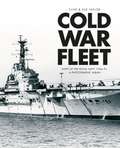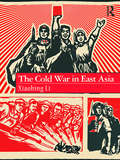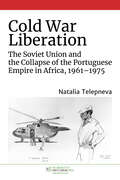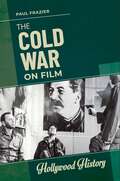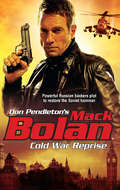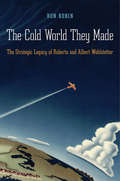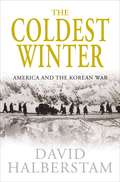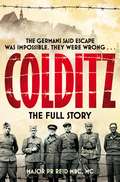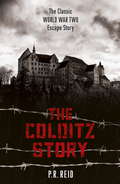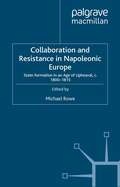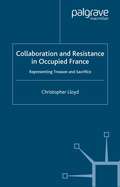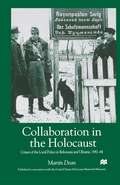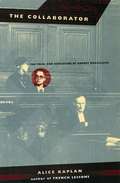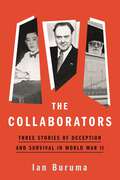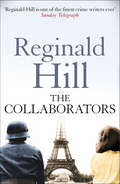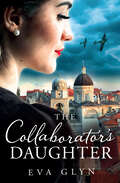- Table View
- List View
Cold War Delta Prototypes: The Fairey Deltas, Convair Century-series, and Avro 707 (X-Planes #15)
by Tony ButtlerAt the dawn of the supersonic jet age, aircraft designers were forced to devise radical new planforms that suited the new power of the jet engine. One of the most successful was the delta wing. Although Gloster produced the delta wing Javelin, and Boulton Paul –its P.111 research aircraft – Fairey and Avro were the champions of the delta in Britain. Meanwhile in America, with the exception of Douglas's Navy jet fighter programmes, Convair largely had the delta wing to itself. These development lines, one on each side of the Atlantic, had essentially the same objective – to produce high-speed fighter aircraft. In Britain, the Fairey Delta 2 went on to break the World Air Speed Record in spectacular fashion, but it failed to win a production order. In contrast Convair received major orders for two jet fighter types and one jet bomber. At the same time, the British Avro company built the 707 family of research aircraft, which led to the famous Vulcan, to show how the delta wing could be adopted for a highly successful subsonic bomber. This book examines the development of the delta wing in Britain and America, and the way in which experimental aircraft like the Fairey Deltas proved their potential and versatility. In Britain it covers the Fairey Delta 1 and Fairey Delta 2, the proposed Fairey Delta Rocket Fighter and huge Delta 3 long range interceptor, and the Avro 707. On the American side, it examines the Convair XF-92 and XF-92A, the development of the Delta Dagger/Delta Dart family, and the Convair Sea Dart – the world's only supersonic seaplane.
Cold War Fleet: Ships of the Royal Navy 1966–91 A Photographic Album
by Clive Taylor Sue TaylorCold War Fleet is a selection of photographs of Royal Navy vessels from the 25 years from 1966 to 1991. Each is reproduced at an exceptionally high standard, accompanied by a detailed caption. Many of the photos are completely unique and have never been published, such as the images of the minesweepers HMS Wilton and HMS Bossington photographed during Operation Rheostat in 1974. There are many ships displayed that took part in the Falklands conflict and a large number of aerial photographs. Created by two of the most acclaimed naval photographers in the world, this stunning book is a window back in time to the Royal Navy of the Cold War, showing a fleet created to defend Britain and other NATO countries from Soviet attack. Featuring every kind of ship from aircraft carriers and destroyers to auxiliary vessels, this is a peerless resource for any enthusiast of naval history.
The Cold War in East Asia
by Xiaobing LiThis textbook provides a survey of East Asia during the Cold War from 1945 to 1991. Focusing on the persistence and flexibility of its culture and tradition when confronted by the West and the US, this book investigates how they intermesh to establish the nations that have entered the modern world. Through the use of newly declassified Communist sources, the narrative helps students form a better understanding of the origins and development of post-WWII East Asia. The analysis demonstrates how East Asia’s position in the Cold War was not peripheral but, in many key senses, central. The active role that East Asia played, ultimately, turned this main Cold War battlefield into a "buffer" between the United States and the Soviet Union. Covering a range of countries, this textbook explores numerous events, which took place in East Asia during the Cold War, including: The occupation of Japan, Civil war in China and the establishment of Taiwan, The Korean War, The Vietnam War, China’s Reforming Movement. Moving away from Euro-American centric approaches and illuminating the larger themes and patterns in the development of East Asian modernity, The Cold War in East Asia is an essential resource for students of Asian History, the Cold War and World History.
The Cold War in East Asia
by Xiaobing LiThis textbook provides a survey of East Asia during the Cold War from 1945 to 1991. Focusing on the persistence and flexibility of its culture and tradition when confronted by the West and the US, this book investigates how they intermesh to establish the nations that have entered the modern world. Through the use of newly declassified Communist sources, the narrative helps students form a better understanding of the origins and development of post-WWII East Asia. The analysis demonstrates how East Asia’s position in the Cold War was not peripheral but, in many key senses, central. The active role that East Asia played, ultimately, turned this main Cold War battlefield into a "buffer" between the United States and the Soviet Union. Covering a range of countries, this textbook explores numerous events, which took place in East Asia during the Cold War, including: The occupation of Japan, Civil war in China and the establishment of Taiwan, The Korean War, The Vietnam War, China’s Reforming Movement. Moving away from Euro-American centric approaches and illuminating the larger themes and patterns in the development of East Asian modernity, The Cold War in East Asia is an essential resource for students of Asian History, the Cold War and World History.
Cold War Liberation: The Soviet Union and the Collapse of the Portuguese Empire in Africa, 1961–1975 (New Cold War History)
by Natalia TelepnevaCold War Liberation examines the African revolutionaries who led armed struggles in three Portuguese colonies—Angola, Mozambique, and Guinea-Bissau—and their liaisons in Moscow, Prague, East Berlin, and Sofia. By reconstructing a multidimensional story that focuses on both the impact of the Soviet Union on the end of the Portuguese Empire in Africa and the effect of the anticolonial struggles on the Soviet Union, Natalia Telepneva bridges the gap between the narratives of individual anticolonial movements and those of superpower rivalry in sub-Saharan Africa during the Cold War. Drawing on newly available archival sources from Russia and Eastern Europe and interviews with key participants, Telepneva emphasizes the agency of African liberation leaders who enlisted the superpower into their movements via their relationships with middle-ranking members of the Soviet bureaucracy. These administrators had considerable scope to shape policies in the Portuguese colonies which in turn increased the Soviet commitment to decolonization in the wider region. An innovative reinterpretation of the relationships forged between African revolutionaries and the countries of the Warsaw Pact, Cold War Liberation is a bold addition to debates about policy-making in the Global South during the Cold War. We are proud to offer this book in our usual print and ebook formats, plus as an open-access edition available through the Sustainable History Monograph Project.
Cold War Liberation: The Soviet Union and the Collapse of the Portuguese Empire in Africa, 1961–1975 (New Cold War History)
by Natalia TelepnevaCold War Liberation examines the African revolutionaries who led armed struggles in three Portuguese colonies—Angola, Mozambique, and Guinea-Bissau—and their liaisons in Moscow, Prague, East Berlin, and Sofia. By reconstructing a multidimensional story that focuses on both the impact of the Soviet Union on the end of the Portuguese Empire in Africa and the effect of the anticolonial struggles on the Soviet Union, Natalia Telepneva bridges the gap between the narratives of individual anticolonial movements and those of superpower rivalry in sub-Saharan Africa during the Cold War. Drawing on newly available archival sources from Russia and Eastern Europe and interviews with key participants, Telepneva emphasizes the agency of African liberation leaders who enlisted the superpower into their movements via their relationships with middle-ranking members of the Soviet bureaucracy. These administrators had considerable scope to shape policies in the Portuguese colonies which in turn increased the Soviet commitment to decolonization in the wider region. An innovative reinterpretation of the relationships forged between African revolutionaries and the countries of the Warsaw Pact, Cold War Liberation is a bold addition to debates about policy-making in the Global South during the Cold War. We are proud to offer this book in our usual print and ebook formats, plus as an open-access edition available through the Sustainable History Monograph Project.
The Cold War on Film (Hollywood History)
by Paul FrazierThe Cold War on Film illustrates how to use film as a teaching tool. It stands on its own as an account of both the war and the major films that have depicted it.Memories of the Cold War have often been shaped by the popular films that depict it—for example, The Manchurian Candidate, The Hunt for Red October, and Charlie Wilson's War, among others. The Cold War on Film examines how the Cold War has been portrayed through a selection of 10 iconic films that represent it through dramatization and storytelling, as opposed to through documentary footage.The book includes an introduction to the war's history and a timeline of events. Each of the 10 chapters that follow focuses on a specific Cold War film. Chapters offer a uniquely detailed level of historical context for the films, weighing their depiction of events against the historical record and evaluating how well or how poorly those films reflected the truth and shaped public memory and discourse over the war. A comprehensive annotated bibliography of print and electronic sources aids students and teachers in further research.
The Cold War on Film (Hollywood History)
by Paul FrazierThe Cold War on Film illustrates how to use film as a teaching tool. It stands on its own as an account of both the war and the major films that have depicted it.Memories of the Cold War have often been shaped by the popular films that depict it—for example, The Manchurian Candidate, The Hunt for Red October, and Charlie Wilson's War, among others. The Cold War on Film examines how the Cold War has been portrayed through a selection of 10 iconic films that represent it through dramatization and storytelling, as opposed to through documentary footage.The book includes an introduction to the war's history and a timeline of events. Each of the 10 chapters that follow focuses on a specific Cold War film. Chapters offer a uniquely detailed level of historical context for the films, weighing their depiction of events against the historical record and evaluating how well or how poorly those films reflected the truth and shaped public memory and discourse over the war. A comprehensive annotated bibliography of print and electronic sources aids students and teachers in further research.
Cold War Reprise
by Don PendletonEarly in his blitz days, Mack Bolan single-handedly shook the KGB to its core. Now intelligence puts him in a face-off with Spetsnaz soldiers revitalized as the new enforcement arm of old-guard Russia.
The Cold World They Made.pdf: The Strategic Legacy Of Roberta And Albert Wohlstetter
by Ron Theodore RobinIn the heady days of the Cold War, when the Bomb loomed large in the ruminations of Washington's wise men, policy intellectuals flocked to the home of Albert and Roberta Wohlstetter to discuss deterrence and doomsday. 'The Cold World They Made' takes a fresh look at the original power couple of strategic studies. Seeking to unravel the complex tapestry of the Wohlstetters' world and worldview, Ron Robin reveals fascinating insights into an unlikely husband-and-wife pair who, at the height of
The Coldest Winter: America And The Korean War
by David HalberstamUp until now, the Korean War has been the black hole of modern American history. The Coldest Winter changes that, giving readers a masterful narrative of the political decisions and miscalculations on both sides. He charts the disastrous path that led to the massive entry of Chinese forces near the Yalu, and that caught Douglas MacArthur and his soldiers by surprise. He provides astonishingly vivid and nuanced portraits of all the major figures -- Eisenhower, Truman, Acheson, Kim, and Mao, and Generals MacArthur, Almond, and Ridgway. At the heart of the book are the individual stories of the soldiers on the front lines who were left to deal with the consequences of the dangerous misjudgments and competing agendas of powerful men. We meet them, follow them, and see some of the most dreadful battles in history through their eyes. As ever, Halberstam was concerned with the extraordinary courage and resolve of people asked to bear an extraordinary burden. Contemporary history in its most literary and luminescent form, The Coldest Winter provides crucial perspective on the Vietnam War and the events of today.
Colditz: The Full Story (Pan Military Classics Series)
by P R ReidIn Colditz: The Full Story, Major Pat Reid brings together the many dramatic discoveries resulting from researh that has covered the five continents. From all walks of life, Belgian, Czech, Dutch, French, German and Polish prisoners - as well as those from the British Commonwealth and USA - were incarcerated in suffocating intimacy for five years in an alien and hostile land. Under these conditions, they proved that men could live together and that loyalty and generosity could thrive, transcending the natural prejudices of race, creed, language and intellecual diversity. There were more than 300 escape attempts at Colditz and in this fascinating portrayal, Reid vividly describes this unique period in Second World War history. Furthermore, he reveals the code systems between the War Ofiice and Colditz; shows how he obtained information on Germany's secret weapons; and investigates the existence of traitors and the situation of non-collaborators in the castle. This is a true story, which nonetheless possesses the mythical qualities that cause a legend to live forever.
The Colditz Story: The Full Story
by Major P ReidColditz was the last stop for prisoners of war during WWII. Those who persisted in escaping from other camps were sent to the impregnable fortress of Colditz Castle, situated on a rocky outcrop high above the River Mulde. Once within the walls of the castle, the Germans reasoned, escape was impossible. And yet many prisoners attempted escape and many succeeded Pat Reid was one of those men. Appointed 'Escape Officer' by his fellow inmates, he masterminded many of the attempts. From tunnelling, to hiding in rubbish sacks, disguising themselves as German officers and even leaping from the castle walls, nothing was too dangerous or foolhardy compared to imprisonment by the enemy. Reid's own escape, in 1942, was both one of the most simple and the most daring. First published in 1952, The Colditz Story is a classic escape story in the tradition of The Great Escape and The Wooden Horse.
Collaboration and Resistance in Napoleonic Europe: State Formation in an Age of Upheaval, c.1800-1815
by M. RoweIn this fascinating study Michael Rowe focuses on state-formation in Napoleonic Europe. It brings together the research findings of specialists in the histories of Europe's constituent nations and states during a momentous period in their development. Thematically focused and integrated within a comparative framework, the individual contributions explore areas as diverse as Britain, France, Germany, Hungary, Italy, Poland, Spain and Russia. What impact did Napoleon have on these nations, and how did they respond to his challenge?
Collaboration and Resistance in Occupied France: Representing Treason and Sacrifice
by C. LloydThis book is about how people behaved during the German occupation of France during World War Two, and more specifically about how individuals from different social and political backgrounds recorded and reflected on their experiences during and after these tragic events. The book focuses on the concepts of treason and sacrifice, and takes the form of an introductory overview, followed by contextualised case studies in the areas of politics, daily life, civil administration, paramilitary action, literature and film.
Collaboration in the Holocaust: Crimes of the Local Police in Belorussia and Ukraine, 1941-44
by M. DeanWhat was the role played by local police volunteers in the Holocaust? Using powerful eye-witness descriptions from the towns and villages of Belorussia and Ukraine, Martin Dean's new book reveals local policemen as hands-on collaborators of the Nazis. They brutally drove Jewish neighbors from their homes and guarded them closely on the way to their deaths. Some distinguished themselves as ruthless murders. Outnumbering German police manpower in these areas, the local police were the foot-soldiers of the Holocaust in the east.
The Collaborator: The Trial and Execution of Robert Brasillach (Studies In Law And Economics Ser.)
by Alice KaplanOn February 6, 1945, Robert Brasillach was executed for treason by a French firing squad. He was a writer of some distinction—a prolific novelist and a keen literary critic. He was also a dedicated anti-Semite, an acerbic opponent of French democracy, and editor in chief of the fascist weekly Je Suis Partout, in whose pages he regularly printed wartime denunciations of Jews and resistance activists. Was Brasillach in fact guilty of treason? Was he condemned for his denunciations of the resistance, or singled out as a suspected homosexual? Was it right that he was executed when others, who were directly responsible for the murder of thousands, were set free? Kaplan's meticulous reconstruction of Brasillach's life and trial skirts none of these ethical subtleties: a detective story, a cautionary tale, and a meditation on the disturbing workings of justice and memory, The Collaborator will stand as the definitive account of Brasillach's crime and punishment. A National Book Award Finalist A National Book Critics Circle Award Finalist "A well-researched and vivid account."—John Weightman, New York Review of Books "A gripping reconstruction of [Brasillach's] trial."—The New Yorker "Readers of this disturbing book will want to find moral touchstones of their own. They're going to need them. This is one of the few works on Nazism that forces us to experience how complex the situation really was, and answers won't come easily."—Daniel Blue, San Francisco Chronicle Book Review "The Collaborator is one of the best-written, most absorbing pieces of literary history in years."—David A. Bell, New York Times Book Review "Alice Kaplan's clear-headed study of the case of Robert Brasillach in France has a good deal of current-day relevance. . . . Kaplan's fine book . . . shows that the passage of time illuminates different understandings, and she leaves it to us to reflect on which understanding is better."—Richard Bernstein, The New York Times
The Collaborator: The Trial and Execution of Robert Brasillach (Studies In Law And Economics Ser.)
by Alice KaplanOn February 6, 1945, Robert Brasillach was executed for treason by a French firing squad. He was a writer of some distinction—a prolific novelist and a keen literary critic. He was also a dedicated anti-Semite, an acerbic opponent of French democracy, and editor in chief of the fascist weekly Je Suis Partout, in whose pages he regularly printed wartime denunciations of Jews and resistance activists. Was Brasillach in fact guilty of treason? Was he condemned for his denunciations of the resistance, or singled out as a suspected homosexual? Was it right that he was executed when others, who were directly responsible for the murder of thousands, were set free? Kaplan's meticulous reconstruction of Brasillach's life and trial skirts none of these ethical subtleties: a detective story, a cautionary tale, and a meditation on the disturbing workings of justice and memory, The Collaborator will stand as the definitive account of Brasillach's crime and punishment. A National Book Award Finalist A National Book Critics Circle Award Finalist "A well-researched and vivid account."—John Weightman, New York Review of Books "A gripping reconstruction of [Brasillach's] trial."—The New Yorker "Readers of this disturbing book will want to find moral touchstones of their own. They're going to need them. This is one of the few works on Nazism that forces us to experience how complex the situation really was, and answers won't come easily."—Daniel Blue, San Francisco Chronicle Book Review "The Collaborator is one of the best-written, most absorbing pieces of literary history in years."—David A. Bell, New York Times Book Review "Alice Kaplan's clear-headed study of the case of Robert Brasillach in France has a good deal of current-day relevance. . . . Kaplan's fine book . . . shows that the passage of time illuminates different understandings, and she leaves it to us to reflect on which understanding is better."—Richard Bernstein, The New York Times
The Collaborator: The Trial and Execution of Robert Brasillach (Studies In Law And Economics Ser.)
by Alice KaplanOn February 6, 1945, Robert Brasillach was executed for treason by a French firing squad. He was a writer of some distinction—a prolific novelist and a keen literary critic. He was also a dedicated anti-Semite, an acerbic opponent of French democracy, and editor in chief of the fascist weekly Je Suis Partout, in whose pages he regularly printed wartime denunciations of Jews and resistance activists. Was Brasillach in fact guilty of treason? Was he condemned for his denunciations of the resistance, or singled out as a suspected homosexual? Was it right that he was executed when others, who were directly responsible for the murder of thousands, were set free? Kaplan's meticulous reconstruction of Brasillach's life and trial skirts none of these ethical subtleties: a detective story, a cautionary tale, and a meditation on the disturbing workings of justice and memory, The Collaborator will stand as the definitive account of Brasillach's crime and punishment. A National Book Award Finalist A National Book Critics Circle Award Finalist "A well-researched and vivid account."—John Weightman, New York Review of Books "A gripping reconstruction of [Brasillach's] trial."—The New Yorker "Readers of this disturbing book will want to find moral touchstones of their own. They're going to need them. This is one of the few works on Nazism that forces us to experience how complex the situation really was, and answers won't come easily."—Daniel Blue, San Francisco Chronicle Book Review "The Collaborator is one of the best-written, most absorbing pieces of literary history in years."—David A. Bell, New York Times Book Review "Alice Kaplan's clear-headed study of the case of Robert Brasillach in France has a good deal of current-day relevance. . . . Kaplan's fine book . . . shows that the passage of time illuminates different understandings, and she leaves it to us to reflect on which understanding is better."—Richard Bernstein, The New York Times
The Collaborator: The Trial and Execution of Robert Brasillach
by Alice KaplanOn February 6, 1945, Robert Brasillach was executed for treason by a French firing squad. He was a writer of some distinction—a prolific novelist and a keen literary critic. He was also a dedicated anti-Semite, an acerbic opponent of French democracy, and editor in chief of the fascist weekly Je Suis Partout, in whose pages he regularly printed wartime denunciations of Jews and resistance activists. Was Brasillach in fact guilty of treason? Was he condemned for his denunciations of the resistance, or singled out as a suspected homosexual? Was it right that he was executed when others, who were directly responsible for the murder of thousands, were set free? Kaplan's meticulous reconstruction of Brasillach's life and trial skirts none of these ethical subtleties: a detective story, a cautionary tale, and a meditation on the disturbing workings of justice and memory, The Collaborator will stand as the definitive account of Brasillach's crime and punishment. A National Book Award Finalist A National Book Critics Circle Award Finalist "A well-researched and vivid account."—John Weightman, New York Review of Books "A gripping reconstruction of [Brasillach's] trial."—The New Yorker "Readers of this disturbing book will want to find moral touchstones of their own. They're going to need them. This is one of the few works on Nazism that forces us to experience how complex the situation really was, and answers won't come easily."—Daniel Blue, San Francisco Chronicle Book Review "The Collaborator is one of the best-written, most absorbing pieces of literary history in years."—David A. Bell, New York Times Book Review "Alice Kaplan's clear-headed study of the case of Robert Brasillach in France has a good deal of current-day relevance. . . . Kaplan's fine book . . . shows that the passage of time illuminates different understandings, and she leaves it to us to reflect on which understanding is better."—Richard Bernstein, The New York Times
The Collaborator: The Trial and Execution of Robert Brasillach
by Alice KaplanOn February 6, 1945, Robert Brasillach was executed for treason by a French firing squad. He was a writer of some distinction—a prolific novelist and a keen literary critic. He was also a dedicated anti-Semite, an acerbic opponent of French democracy, and editor in chief of the fascist weekly Je Suis Partout, in whose pages he regularly printed wartime denunciations of Jews and resistance activists. Was Brasillach in fact guilty of treason? Was he condemned for his denunciations of the resistance, or singled out as a suspected homosexual? Was it right that he was executed when others, who were directly responsible for the murder of thousands, were set free? Kaplan's meticulous reconstruction of Brasillach's life and trial skirts none of these ethical subtleties: a detective story, a cautionary tale, and a meditation on the disturbing workings of justice and memory, The Collaborator will stand as the definitive account of Brasillach's crime and punishment. A National Book Award Finalist A National Book Critics Circle Award Finalist "A well-researched and vivid account."—John Weightman, New York Review of Books "A gripping reconstruction of [Brasillach's] trial."—The New Yorker "Readers of this disturbing book will want to find moral touchstones of their own. They're going to need them. This is one of the few works on Nazism that forces us to experience how complex the situation really was, and answers won't come easily."—Daniel Blue, San Francisco Chronicle Book Review "The Collaborator is one of the best-written, most absorbing pieces of literary history in years."—David A. Bell, New York Times Book Review "Alice Kaplan's clear-headed study of the case of Robert Brasillach in France has a good deal of current-day relevance. . . . Kaplan's fine book . . . shows that the passage of time illuminates different understandings, and she leaves it to us to reflect on which understanding is better."—Richard Bernstein, The New York Times
The Collaborator: The Trial and Execution of Robert Brasillach (Studies In Law And Economics Ser.)
by Alice KaplanOn February 6, 1945, Robert Brasillach was executed for treason by a French firing squad. He was a writer of some distinction—a prolific novelist and a keen literary critic. He was also a dedicated anti-Semite, an acerbic opponent of French democracy, and editor in chief of the fascist weekly Je Suis Partout, in whose pages he regularly printed wartime denunciations of Jews and resistance activists. Was Brasillach in fact guilty of treason? Was he condemned for his denunciations of the resistance, or singled out as a suspected homosexual? Was it right that he was executed when others, who were directly responsible for the murder of thousands, were set free? Kaplan's meticulous reconstruction of Brasillach's life and trial skirts none of these ethical subtleties: a detective story, a cautionary tale, and a meditation on the disturbing workings of justice and memory, The Collaborator will stand as the definitive account of Brasillach's crime and punishment. A National Book Award Finalist A National Book Critics Circle Award Finalist "A well-researched and vivid account."—John Weightman, New York Review of Books "A gripping reconstruction of [Brasillach's] trial."—The New Yorker "Readers of this disturbing book will want to find moral touchstones of their own. They're going to need them. This is one of the few works on Nazism that forces us to experience how complex the situation really was, and answers won't come easily."—Daniel Blue, San Francisco Chronicle Book Review "The Collaborator is one of the best-written, most absorbing pieces of literary history in years."—David A. Bell, New York Times Book Review "Alice Kaplan's clear-headed study of the case of Robert Brasillach in France has a good deal of current-day relevance. . . . Kaplan's fine book . . . shows that the passage of time illuminates different understandings, and she leaves it to us to reflect on which understanding is better."—Richard Bernstein, The New York Times
The Collaborators: Three Stories of Deception and Survival in World War II
by Ian Buruma'The Collaborators is at once fascinating and frightening, an apposite tract for our increasingly mendacious, treacherous times.' John BanvilleOn the face of it, the three characters here seem to have little in common - aside from the fact that each committed wartime acts that led some to see them as national heroes, and others as villains. All three were mythmakers, larger-than-life storytellers, for whom the truth was beside the point. Felix Kersten was a plump Finnish pleasure-seeker who became Heinrich Himmler's indispensable personal masseur - Himmler calling him his 'magic Buddha'. Kersten presented himself after the war as a resistance hero who convinced Himmler to save countless people from mass murder. Kawashima Yoshiko, a gender fluid Manchu princess, spied for the Japanese secret police in China, and was mythologized by the Japanese as a heroic combination of Mata Hari and Joan of Arc. Friedrich Weinreb was a Hasidic Jew in Holland who took large amounts of money from fellow Jews in an imaginary scheme to save them from deportation, while in fact betraying some of them to the German secret police. Sentenced after the war as a traitor and a con artist, he is still regarded by supporters as the 'Dutch Dreyfus'. All three figures have been vilified and mythologized, out of a never-ending need, Ian Buruma argues, to see history, and particularly war, and above all World War II, as a neat tale of angels and devils. In telling their often-self-invented stories, The Collaborators offers a fascinating reconstruction of what in fact we can know about these fantasists and what will always remain out of reach. It is also an examination of the power and credibility of history: truth is always a relative concept but perhaps especially so in times of political turmoil, not unlike our own.
The Collaborators (Isis Cassettes Ser.)
by Reginald HillFrom the bestselling author of the Dalziel and Pascoe series, a superb novel of wartime passion, loyalty – and betrayal
The Collaborator’s Daughter
by Eva GlynIn 1944 in war-torn Dubrobvnik Branko Milisic holds his newborn daughter Safranka and wishes her a better future. But while the Nazis are finally retreating, the arrival of the partisans brings new dangers for Branko, his wife Dragica and their new baby…

